|
Upcountry South
Carolina is the northwest corner of the state,
along the North Carolina border and the Blue
Ridge Mountains. It has many historical,
natural, and cultural treasures. Many of these
attractions can be visited during a pandemic and
Oconee Station is one of those. It a South
Carolina State Historic Site that includes one
of the prettiest waterfalls in the Upstate,
Station Cove Falls. Travelers along Interstate
85 that want a more scenic and less-crowded view
of South Carolina should consider the Cherokee
Foothills Scenic Highway (state highway 11). It
runs from the Georgia line to Gaffney, South
Carolina, about 15 miles from the North Carolina
border. There are lots of attractions that can
be visited while social distancing, including
Oconee Station, and even a Revolutionary War
Battlefield at Cowpens.
Oconee Station’s
historical interest centers on two buildings
from the late eighteenth and early nineteenth
centuries. The site encompasses 210 acres with a
1.5-mile interpretative nature trail through
wildflowers and wilderness. Part of the trail
circles a four-acre stocked fishing pond.
Oconee Station
In the late
eighteenth century, the Upcountry was the
western frontier. White settlers and Native
Americans clashed, resulting in skirmishes and
massacres. In 1792, General Robert Anderson
decided the western frontier needed defenses and
designated what they would be: “I have ordered
the people to build blockhouses, where they are
exposed and intimidated, to fly with their
families, in case of alarm. I have frontier
blockhouses built and building, at suitable
places along our frontiers, at the distance of
about eight or ten miles apart. I have ordered
trusty spies to be constantly kept out at Tugalo
and at the Oconee Mountain, as they are the
spots … which be most exposed.” The area
around Oconee Station is the center of what the
interpretative historical marker calls “the
South Carolina frontier experience.”
Oconee Station is one
of those frontier blockhouses, the only
remaining one. As a military outpost, it served
as a westernmost defensive point for new
settlers. Scouts based at these stations roamed
the frontier areas and served as an early
warning network for imminent Indian attacks,
giving the alarm to local white settlers who
could retreat to the stations. It served as a
garrisoned fort for armed troops, with the
blockhouse being the central protective
structure. This site was the only station on the
South Carolina frontier that remained in
operation after 1796. Its use by the military
ended in 1799 when the threat of Indian attacks
subsided. The station was also used as a trading
post. Trader William Richards came to live at
the station in 1795, and, in 1805, built a brick
residence next to the blockhouse. Since the
station served as a military fort and trading
post, it provides insights into the complex and
changing relationships between Southeastern
Indians and white settlers, as the whites gained
land and the Indian Territory was pushed
westward.
The interpretive
marker describes its use as a military and
trading post: “The sturdy stone structure at
Oconee Station housed as many as 30 soldiers at
a time, over a period of about eight years. We
can only guess at the number of deerskins that
passed through its doors during and since that
time. Deerskins were in high demand in Europe,
and Southeastern Indians responded by hunting
millions of deer annually for trade. In
exchange, they received weapons, cotton and
linen fabrics, rum, ornaments, metal tools, and
other items. European guns made it easier for
Indians to hunt deer, but weapons were also
valuable for defense against their enemies.
Though trade was beneficial to both sides, it
was disruptive of traditional Native American
life, particularly as hunters spent more time
away from home. The Indians bartered other goods
such as baskets, ginseng, and snakeroot, but
deerskins remained their main trade good until
Indian removal from the Southeast.”
State Highway 11, the
Cherokee Foothills Scenic Highway, roughly
parallels the Cherokee path in places. Oconee
Station was built near the main Cherokee Lower
Towns. The Upcountry is full of historical
markers describing the state’s frontier history.
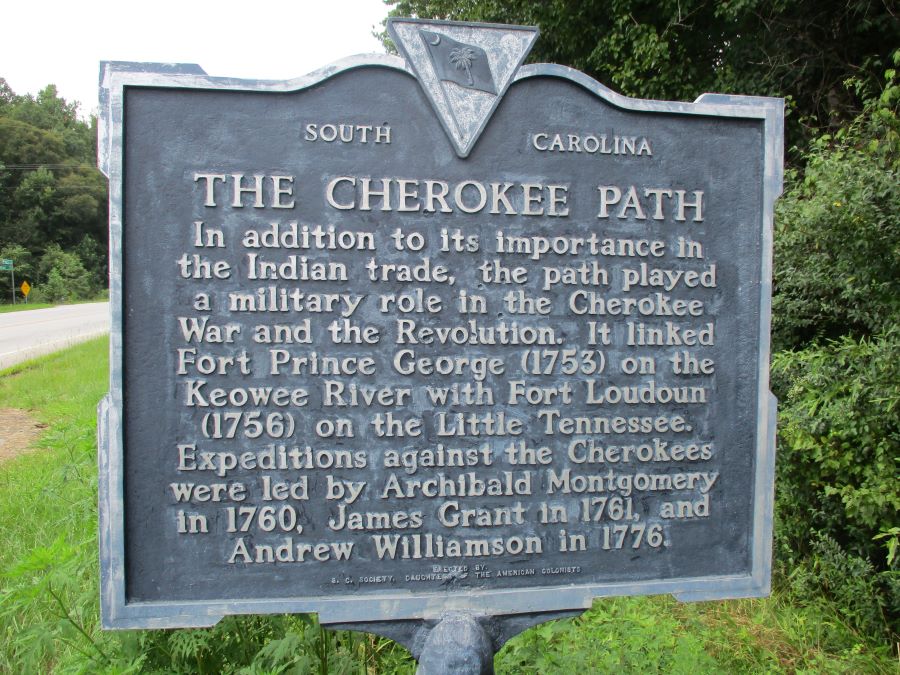 |
| An historical marker on
Highway 11: “The main trading path to
the Cherokee Nation paralleled the route
of Highway 11 for several miles at this
point, This section of the path was used
by travelers going from Keowee, the main
Lower Town of the Cherokees, across the
mountains to the Middle and Overhill
Towns. The botanist William Bartram left
a written journal of his journey in
1776.” |
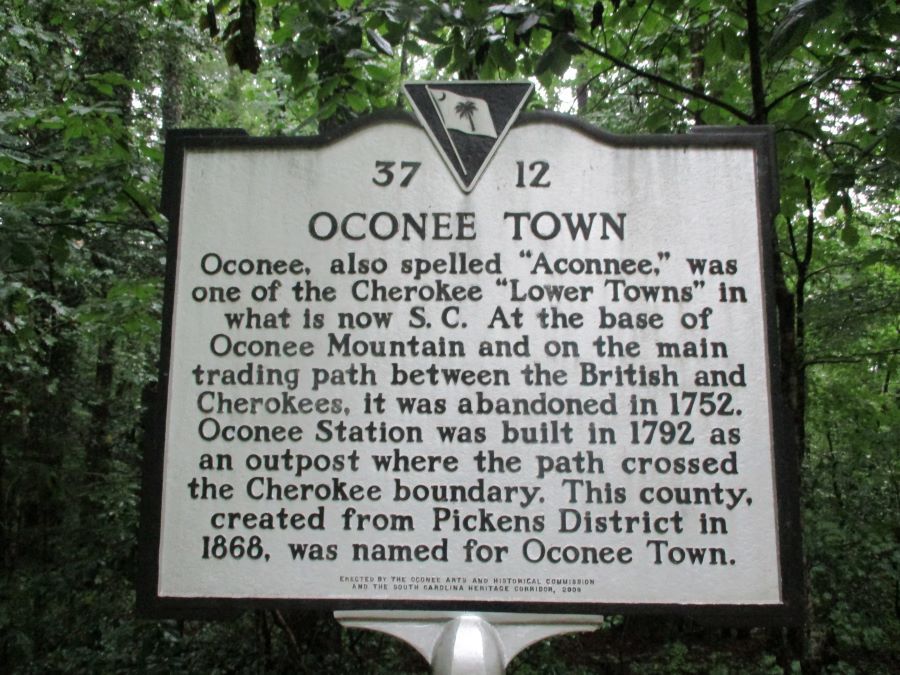 |
| An historical marker at Oconee
Station recognizes the station is
located beside one of the important
Cherokee Lower Towns. |
 |
| The two remaining building are
situated near each other atop a hill.
There were additional buildings that did
not survive and likely some sort of fort
structure. Note the defensive design of
both buildings. |
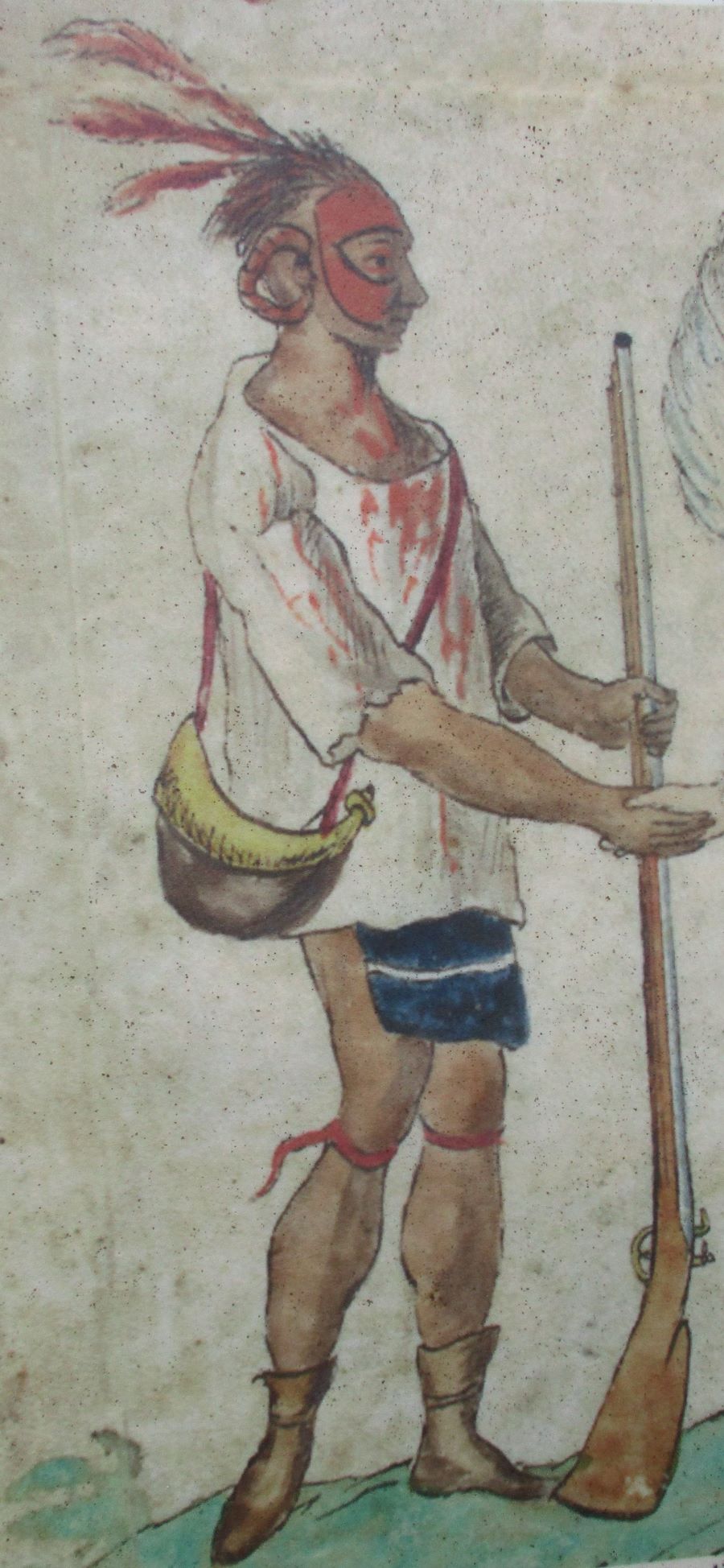 |
| Okana-Stoté, Chief of the
Cherokee Nation, 1761. |
 |
| Recruited from the “hardiest
and best hunters,” the garrison
consisted of infantry, mounted infantry,
and scouts. |
The inside of both
buildings is relatively bare, intended to expose
the architecture of the structures. The
blockhouse was obviously built for defense, with
thick walls and high, narrow, and deepset
windows. The main floor has two rooms with a
large chimney in the center that furnished two
fireplaces. There is a basement and a second
story. The house was surrounded by an old
English garden and was tended by the sister of
the trading post owners. She came from England
to tend for her bothers. Her grave is at the
foot of the hill, with a tombstone that reads,
“Margaret Richards who crossed the ocean for
love of her bothers.”
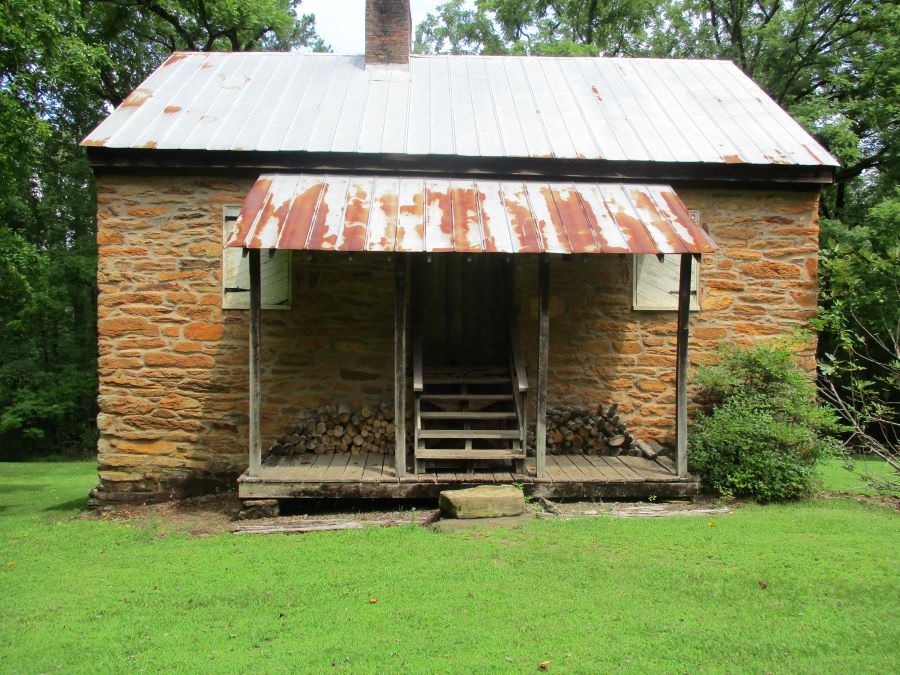 |
| The blockhouse is all that
remains of the small fort at Oconee
Station, built as a response to Indian
raids along the western frontier. Built
in 1792, it was garrisoned by 30
militiamen. By 1799 it was no longer
necessary to garrison troops at the
station.
|
 |
| The inside of the blockhouse. |
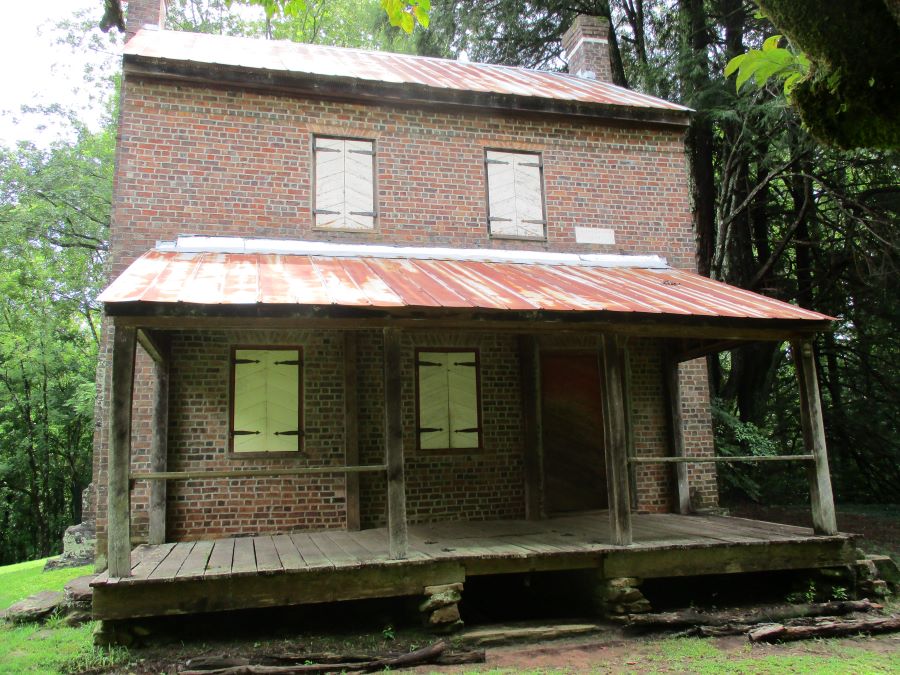 |
| Established in 1795, the
trading post at Oconee Station was owned
an Irish immigrant named William
Richards. Wagonloads of skins and furs
were exchanged for everything from gun
flints to livestock. In addition to
thousands of acres of land and 11
enslaved workers, Mr. Richards was able
to afford a two-story brick home, built
in 1805, in an area where log cabins
were the norm. His estate inventory in
1809 listed 15 tons of deerskins, 329
beer skins, 82 pounds of ginseng, and
many other sundry items. As the frontier
moved westward, the economic importance
of Oconee Station declined.
|
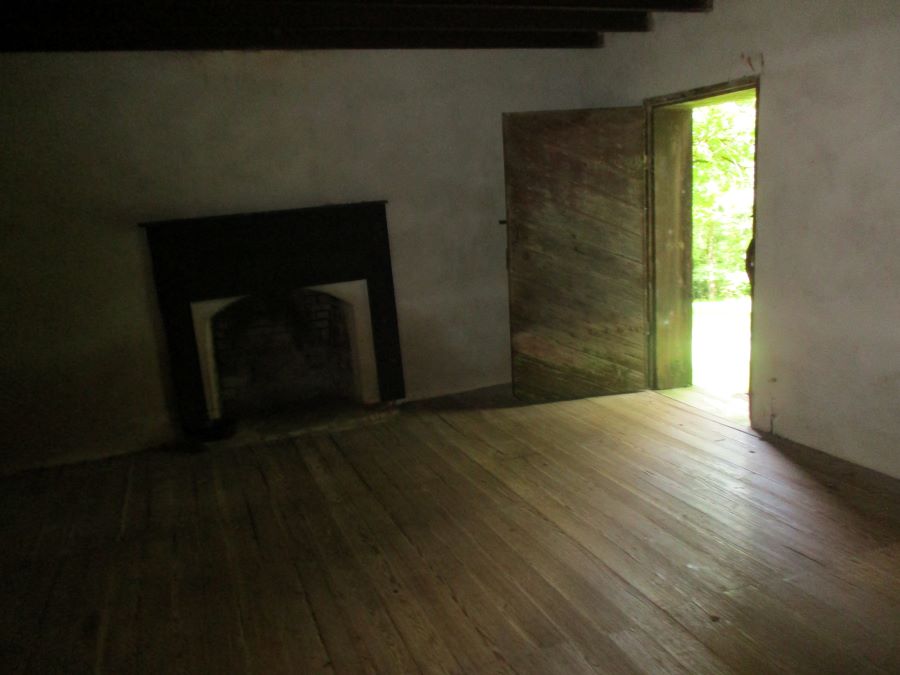 |
| The inside of the trader’s
brick house. Notice, like the
blockhouse, it was built for defense.
|
Station
Cove Falls
Getting to Station
Cove Falls involves a half-mile (one way) trail
that passes through one of South Carolina’s most
uncommon and treasured natural areas, a place of
beauty and biodiversity. More than 250 species
of plants are known to occur in the cove,
including 14 rare plant species. It is named for
nearby historic blockhouse and the steep sided
mountain ravine (or cove) that ends at the base
of a spectacular 60-foot waterfall. The trail is
well marked and provides a relatively easy hike
as it passes above a beaver enhanced wetland,
along the side of wood slope dominated by oaks
and hickories and across several small streams.
It then enters Station Cove proper.
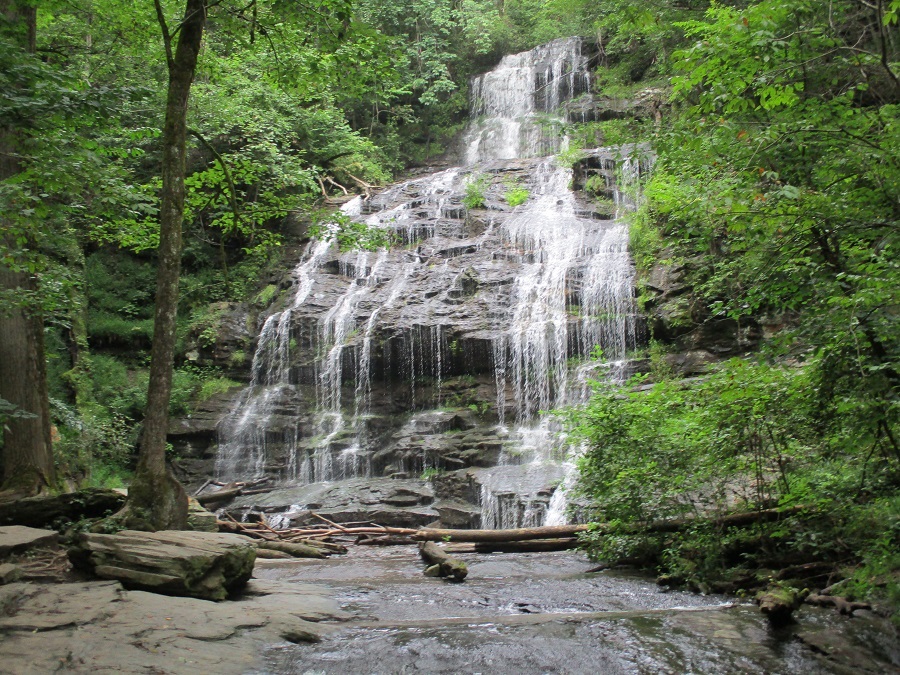 |
| Station Cove Falls, in a
county with numerous waterfalls, that is
perhaps the prettiest.
|
The historical site
has a 1½ mile nature trail that ends at the
Falls. The shorter half-mile trail to the Falls
is part of that longer trail. The well-marked
trailhead of the shorter trail is just up the
main road from the site entrance. The longer
trail begins at the historical site parking lot
and forks soon after it begins. It circles the
large fishing pond and then the two legs come
back together; so, a hiker can go out on one
trail and return on the other.
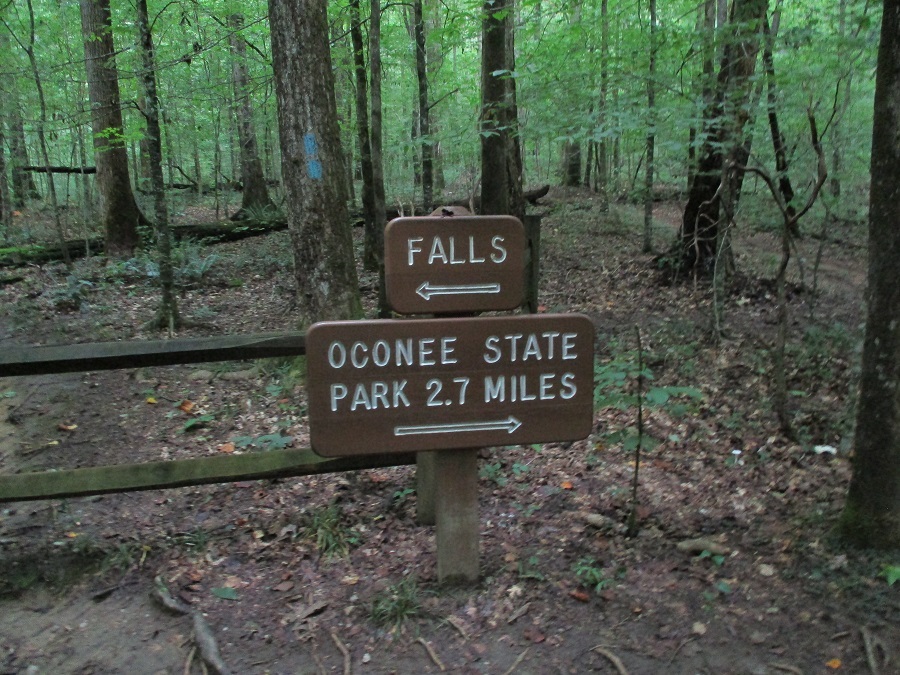 |
| One of the South Carolina’s
favorite state parks, especially for
hikers, is Oconee State Park, with
camping, cabins, and lots of trails. One
trail connects to the Station Cove
Trail. So, it is possible to stay at the
nearby Oconee State Park campground and
visit two great parks in the same day. |
The Blue Ridge
Escarpment and associated Brevard Fault Zone
form the transition zone between the steep
slopes of the Blue Ridge Mountains and the
rolling hills of the Piedmont. This unique
habitat creates a refuge for a variety of plants
that would not normally thrive here. The
escarpment is home to several scenic waterfalls,
including, Station Cove Falls. The waterfall not
only provides natural beauty, but it also
produces another special habitat: the spray
cliffs community. The constant spray from the
waterfall tumbling over rocks and boulders
provides an important home to many species,
including ferns, mosses, liverworts,
salamanders, crayfish and aquatic insects.
The trailhead begins
in a pine and hardwood forest typical of much of
South Carolina’s Piedmont, a rather dry but
interesting habitat that includes plants such as
pink lady slipper orchids and spotted
wintergreen. Further along the trail, as the
habitat changes, monkshood and blood root can be
found. Moisture conditions increase and forest
types change as the trail meanders along Station
Cove Creek. Sometimes you may hear spring
peepers which live in the wetlands adjacent to
the creek. At the end of Station Cove Trail you
will be in one of the most distinct and
botanically diverse habitats in the eastern
United States: a rich cove forest. The grandest
annual show of wildflowers at Station Cove
typically occurs in mid-March when thousands of
trilliums bloom along the trail leading to the
cove. In the spring there are also mayapple,
pink lady’s slipper orchids, bloodroot, and
redbud.
 |
| The trails are
well-maintained, and the terrain is
relatively easy. The walk from the
historical site is through beautiful
forest and wildflowers, and becomes more
and more impressive as the hiker enters
the cove and approaches the waterfall. |
Both Nature and History
The best part of this
road trip stop is that it has strong doses of
both nature and history. The waterfall, forest,
and wildflowers are worth the stop themselves,
but the frontier history is also fascinating.
Taking the scenic highway means other possible
nature stops, like Table Rock State Park and
Caesars Head State Park. The Upcountry has many
revolutionary war battle sites, including large
ones.
Near Oconee Station,
for example, a small, but significant, Indian
fight took place on August 12, 1776. Even though
it was an Indian battle, it was also a
Revolutionary War battle. Cherokees, influenced
by British Loyalists, began to attach western
colonial settlements. The South Carolina militia
responded and a force of 1,100 men began a
scorched earth policy against the Cherokee
villages. One of those Indian villages was
Tamassee, near the future site of Oconee
Station, and Andrew Pickens (who would become a
Revolutionary War General), led a small 25-man
scouting party to locate hostiles near the
village. He was surrounded by a 175-200 Native
Americans. Quick thinking led him to form his 25
men into two circles, one outer circle and a
smaller inner circle, with his men firing
outward; each circle could fire and reload in
order. This became the famous “Ring Fight” in
South Carolina lore. Vastly outnumbered, the
tactic worked, and kept most of the men safe
until reinforcements arrived. Native American
casualties were high and Pickens made his
reputation. There is an historical marker for
the battle only 4.5 miles from the historical
site. Nothing but the marker is there, but if
you want to see the battle site, turn right as
you leave Oconee Station, and proceed to the end
of Oconee Station Road at Tamassee Knob Road;
turn left and in two miles you will end at
Cheohee Valley Road. The historical marker is at
that intersection.
 |
| There were definitely Indian
battles near Oconee Station.
|
None of this is far
from scenic Highway 11, and even if you don’t
stop, Highway 11 is a much more pleasant drive
than the parallel Interstate. The problem is
there are plenty of interesting places along the
route to tempt drivers to make a stop. Oconee
Station is unquestionably one of the most
interesting.
Author:
Thomas J. Straka is a forestry professor
emeritus at Clemson University. He has a keen
interest in political and natural history.
For additional
information:
South Carolina Parks
Official Website
https://southcarolinaparks.com/oconee-station
South Carolina Trails
Website
https://www.sctrails.net/trails/trail/oconee-station
HD Carolina video of
Oconee Station
https://www.hdcarolina.com/episode/oconee-station-state-historic-site
HD Carolina video of
Station Cove Falls
https://www.hdcarolina.com/episode/station-cove-falls
A History of Oconee
Station, South Carolina
https://www.carolana.com/SC/Towns/Oconee_Station_SC.html
|









